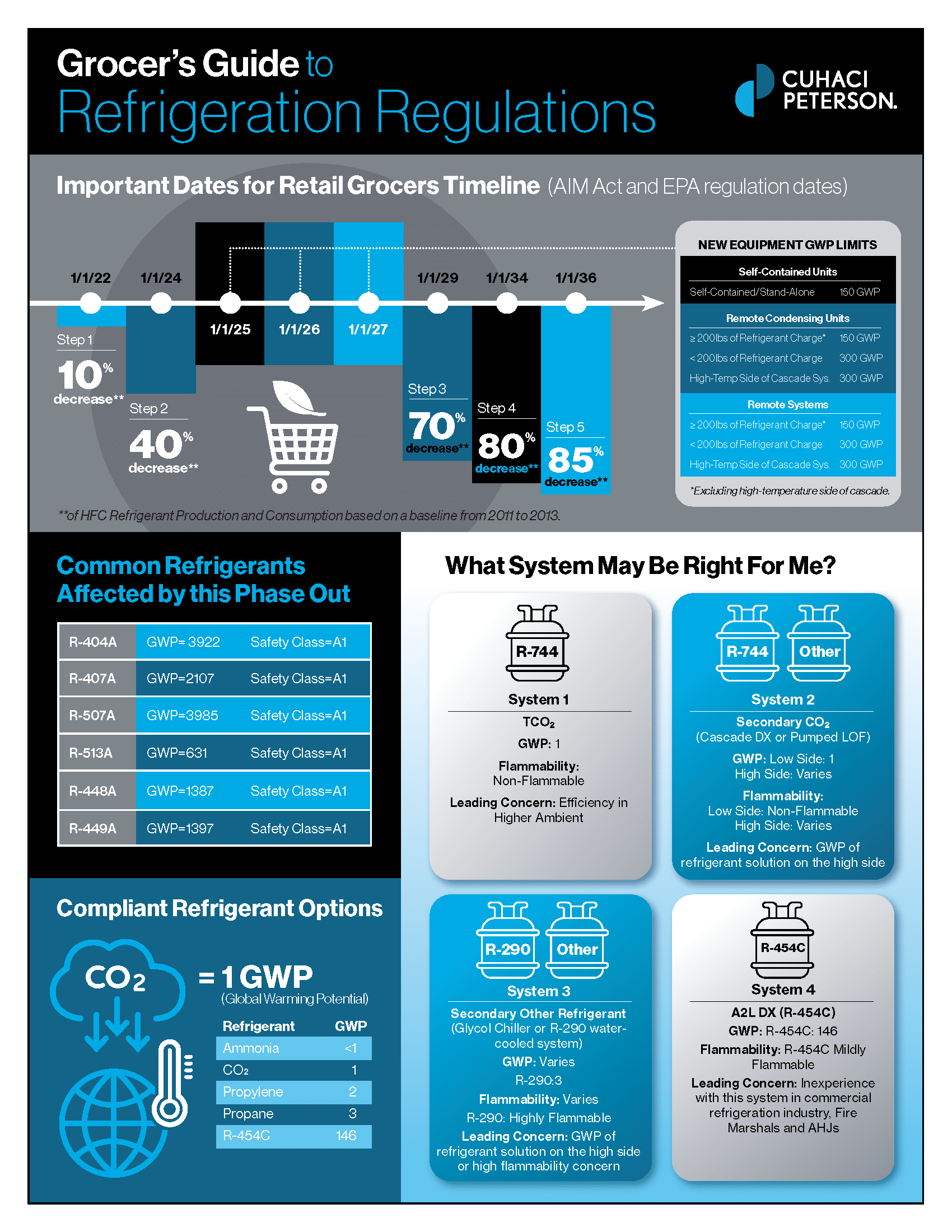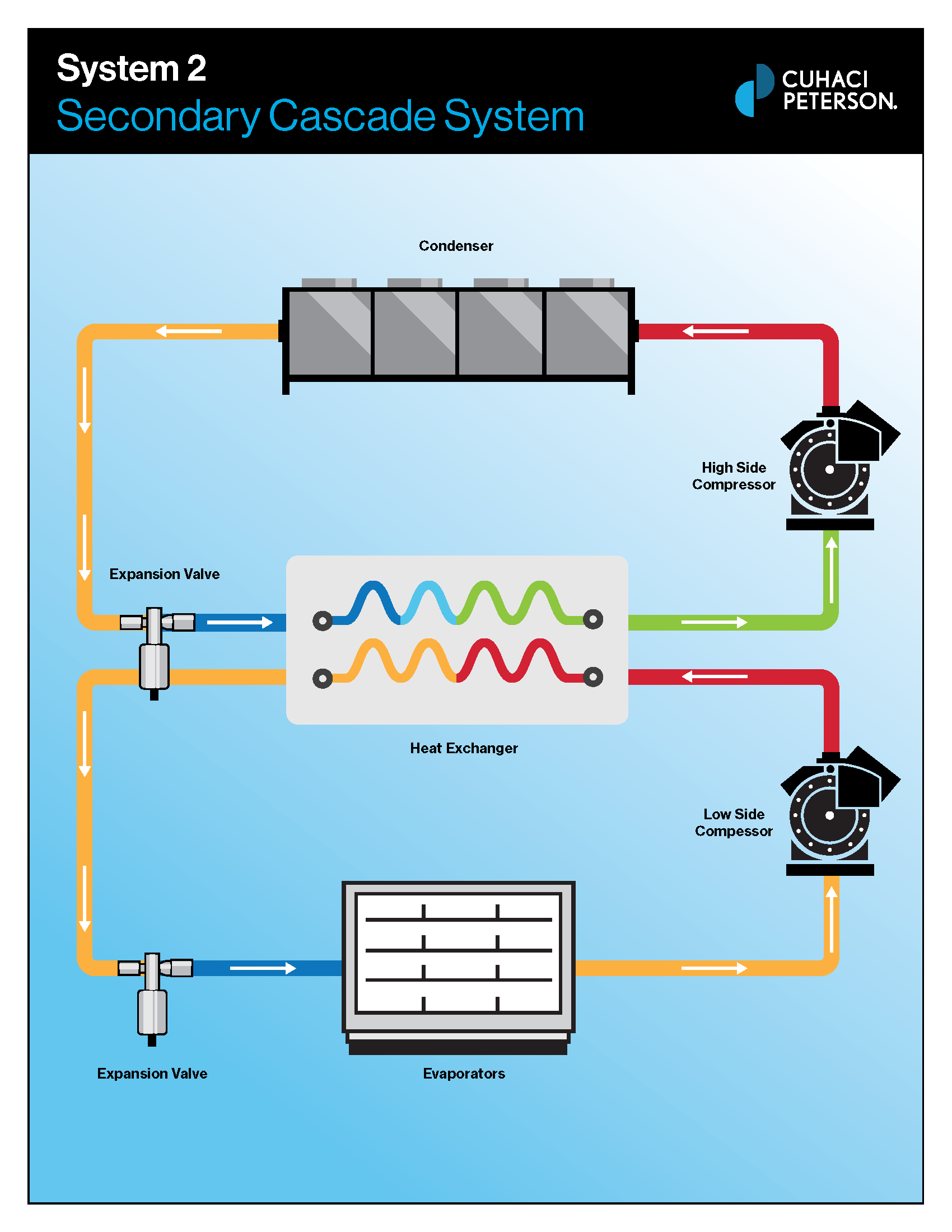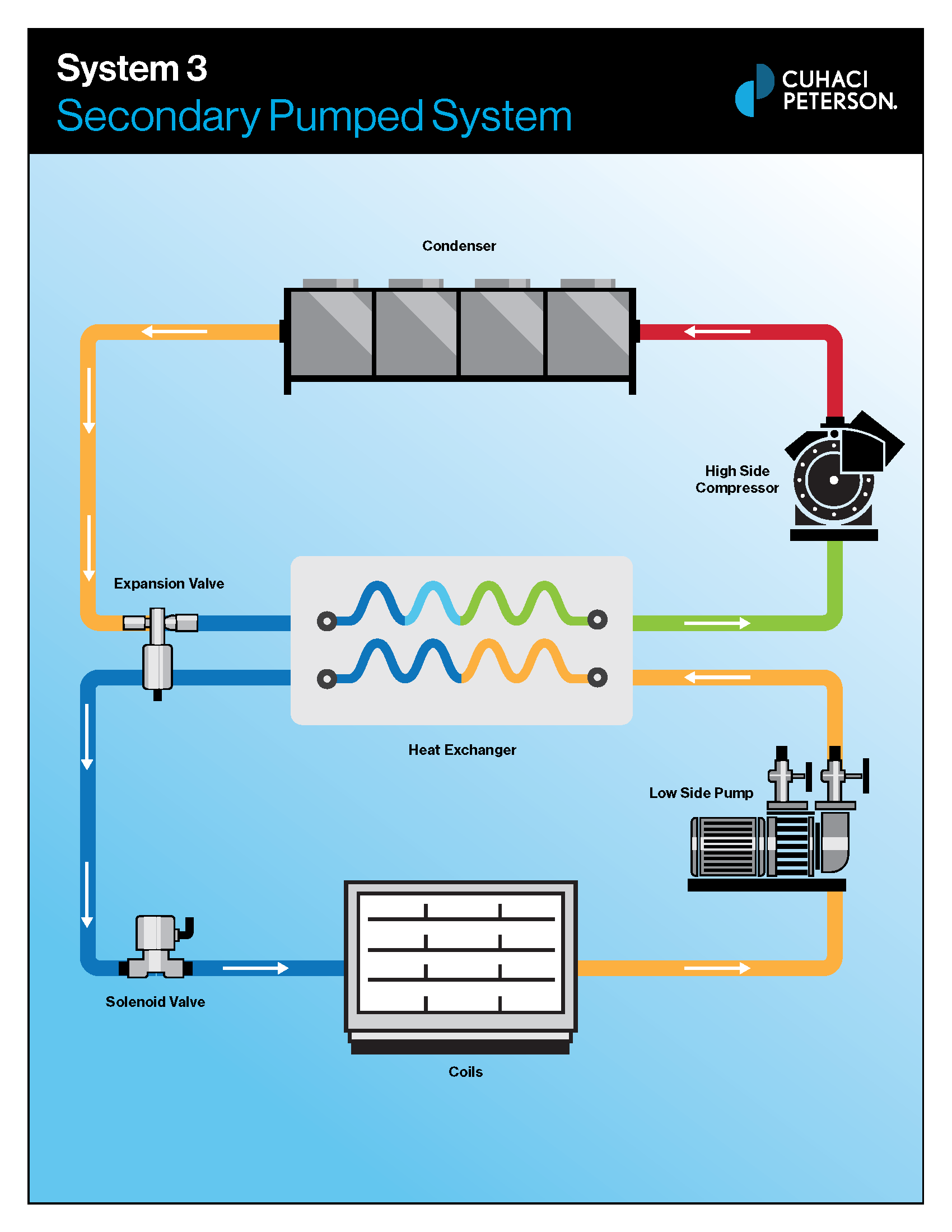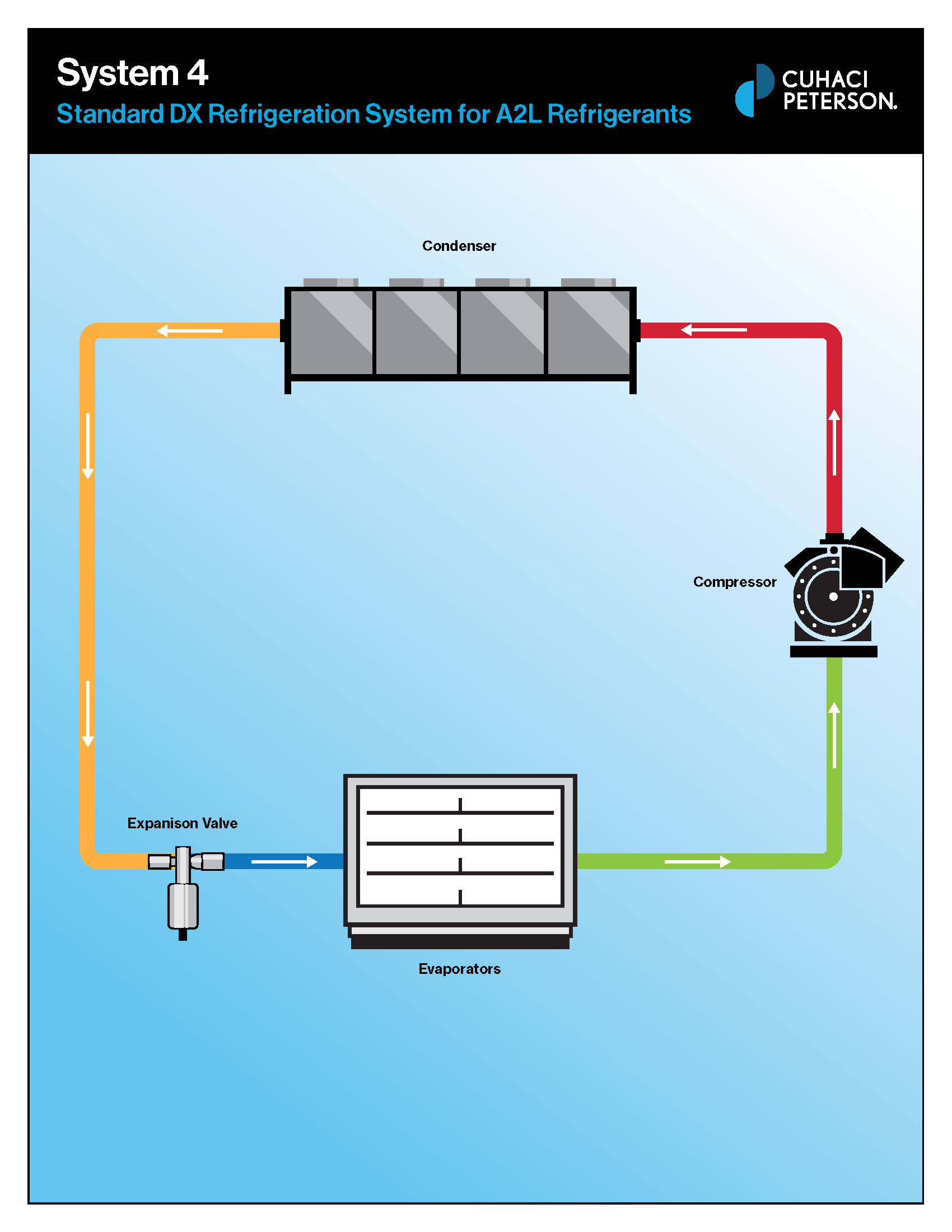Grocer’s Guide to Refrigeration Regulations
At the end of 2020, when many of us were spending time with our friends and family looking forward to the New Year, the U.S.federal government enacted and signed into law the American Innovation and Manufacturing (AIM) Act which was the next domino to fall in refrigeration regulations. The AIM Act looked to align with the Montreal Protocol (specifically the Kigali Agreement), which is a global agreement to address the depletion of the ozone layer and reduce the emissions of greenhouse gases. This set a schedule of the phase down of hydrofluorocarbon (HFC) refrigerants in the U.S. market while also empowering the U.S. Environmental Protection Agency to develop regulations to meet this schedule (See Important Dates for Retail Grocers Timeline). HFC refrigerants were specifically targeted due to their high global warming potential (GWP), which is a measure of how much energy the emissions of 1 ton of a gas will absorb over a given period of time, relative to the emissions of 1 ton of carbon dioxide as defined by the U.S. EPA. At the time of this writing, the EPA has begun managing HFC restrictions by mandating supply restrictions, establishing sector-based GWP limits, and creating/enforcing standards for servicing and repair of systems. For the commercial refrigeration sector, the New Equipment GWP limits table shows the scheduled GWP limits for new manufactured systems.
So what does this legislation mean to end-users today? Well, it certainly poses a huge hurdle in the U.S. market as common refrigerants that are found in grocery stores have a GWP that exceeds 1,000 (see Common Refrigerants Affected by this Phase Out). Do end-users have to have all existing systems replaced by these sector-based GWP limit dates? The short answer is no since these GWP limits only apply to new systems. However, the time to start planning a path forward is now as HFC supply restrictions and service/repair standards are also included in the latest rounds of regulations so the cost of maintaining these existing systems is likely to increase as time goes on. Additionally, the days of retrofitting existing systems by dropping in a new refrigerant and oil are approaching the end as there is no current refrigerant retrofit solution that will not require replacing major components such as compressors, condensers, or cases/coils. So what options do end-users have? Many end-users today are beginning to pivot to future-proof solutions on both remodels and new stores to meet regulatory requirements. Cuhaci Peterson Refrigeration has highlighted a few leading solutions below that are likely to be cornerstones of commercial refrigeration systems.
System 1
Transcritical CO2 Booster System
A system that only uses a non-flammable, low toxicity, natural refrigerant with a GWP of 1 would be one of the clear leaders in the clubhouse of future-proof solutions. Well, that is exactly what we have with a Transcritical CO2 Booster System. The system only uses R-744 (CO2) and can serve both low and medium temperature fixtures simultaneously making it a great option to reduce the number of systems running in a store. Additionally the thermodynamic properties of R-744 sets it up as a great refrigerant with high volumetric cooling capacity, meaning it can produce a lot of cooling with a low compressor displacement requirement. This results in smaller system components (compressors, valves, piping, etc.). So what is the catch? Transcritical CO2 booster systems face efficiency challenges in higher ambient conditions. Your standard refrigeration cycle works by absorbing or releasing energy by converting liquid into a gas and a gas into a liquid through heat transfer. However when refrigerants operate above specific temperatures and pressures, they can no longer be distinguished between a liquid and a gas and operate as a supercritical fluid. This specific temperature and pressure varies between refrigerants and is known as the critical point. As systems approach or exceed this critical point, they lose efficiency. This far and wide has been a non-factor as the critical points of many common refrigerants are well above outside air temperatures. R-744 is an exception. Its critical point is at a temperature of 87.8degF and 1056 PSIG. Therefore, systems that use R-744 and operate above or near its critical temperature require additional components to operate, such as a high-pressure expansion valve, flash gas bypass valve, and flash tank to drop its pressure below the critical point. These additional design solutions add complexity to the operation and installation, which often comes at a premium for end-users. There are ways to makeup for some of these efficiency losses through additional innovative components, such as ejectors, subcooling, and parallel compression, but similarly these additions come with complexity and cost which will continue to be a hurdle for wide acceptance of this system.
System 2
Cascade or Pumped CO2 System
If we review the Transcritical CO2 Booster system, many of the counterpoints stem from utilizing R-744 in hotter climate zones. The easiest solution would be to install the system in a colder climate where the outside temperature stays well below the critical point of R-744 for most of the year. Unfortunately, that is not possible for a large section of the U.S. A great solution to ensure R-744 stays below its critical point is apply it in a cascade arrangement where the CO2 is only serving low temperature loads and is always condensed in a cascade heat exchange below it’s critical temperature by using a high side (non-CO2) refrigeration system to cool it. Another solution is to simply pump and circulate it as a saturated fluid and use a high side (non-CO2) refrigeration system to maintain the temperature of the CO2 and condense any evaporated CO2 back into a liquid. In principle, both systems work and accomplish the same result. They work by having two sides, a high side and low side, running simultaneously. The high side looks familiar to many refrigeration systems found in stores today where you have compressors discharging hot gas to a condenser that condenses the gas to a liquid state. However, instead of the liquid flowing out to a case or coil in the store, it flows to a heat exchanger that condenses the CO2 on the low side. On the low side, R-744 is a great option as we get all the benefits previously mentioned in the previous system while also removing the efficiency concerns in higher ambient temperatures since it is condensed with a heat exchanger that is independent from outside temperatures. On the high side, we are faced with challenges on what refrigerant to use. Pending regulations for new remote systems limit high sides to 300 GWP starting January 1, 2027. This means many of the current HFC refrigerants being used today will not be a viable option long term in the industry. However, a low side CO2 system poses a unique opportunity for remodel applications where an existing HFC rack serving a store’s cases/coils can be converted to be the high side of a newly installed low side system. This is likely to be an intermediate step for many end-users today as it will reduce the amount of HFC refrigerant at a store, utilize R-744 under conditions it is more efficient, and allow for tactical remodels or new builds until all current and future refrigerant options are adopted by regulatory jurisdictions and vetted out by the industry.
System 3
Secondary Other Refrigerant System
As mentioned previously, R-744 certainly has a bright future in commercial refrigeration due to its benefits; however, it should not be expected that R-744 will be the only solution in the industry. Many end-users in the industry have expressed understandable hesitation regarding the transition to R-744. This transition is likely to require higher installation and maintenance costs due to the complexity of the systems, volatility of the fluid, and higher operating pressure conditions. The higher operating pressure conditions also means when a leak does occur, it will leak rapidly and in recent time refrigerant-grade R-744 has faced sporadic supply challenges. Additionally, end-users that are conscious of net-zero goals need to consider how environmentally friendly R-744 systems truly are. Foremost, an argument can be made regarding the amount a grocer’s carbon footprint was lowered if the lower GWP system requires a significant increase in energy consumption where the energy is generated from a source with a high carbon footprint. Secondly, R-744 is typically produced in large industrial plants and must undergo additional refining to achieve a proper refrigerant-grade standard which is often done utilizing fossil fuels. However, when compared to the damage caused by a higher GWP refrigerant, the latter argument is likely insignificant. So the question many end-users approach is what other options are there outside of R-744? One option is to use a similar high side/low side setup as mentioned in the system above, but instead of pumping R-744 we can pump a food-grade water/glycol fluid in a glycol chiller system (a common mixture used today is 35% propylene glycol). However, this system runs into the same challenges as the above regarding many of the current HFC refrigerants being used today will not be a viable option long term in the industry. Additionally, it becomes very inefficient to pump glycol at freezing temperatures because the fluid becomes very difficult to pump with thick concentrations of glycol necessary for freeze protection. Therefore, self-contained fixtures using hydrocarbons such as R-290 (propane) may find their niche in commercial refrigeration. A condensing water loop can be used to cool the condenser on each self-contained fixture and reject the heat to the outdoor ambient through a fluid cooler. Due to the high flammability safety concern of R-290, charge limits are held very low resulting in mini compressor systems being needed at each case/coil. Although the GWP of R-290 is well below the regulatory limits, the safety concern and higher cost of equipment due to individual mini compressor systems often finds this being used on the low temperature applications within stores where a glycol chiller system is used on medium temperature applications.
System 4
Standard DX Refrigeration System for A2L Refrigerants
All previously mentioned systems run into a variety of challenges that result in manufacturers and engineers having to add complexity to the designs when compared to the existing HFC systems that are running in many stores today. A standard direct expansion (DX) refrigeration system utilizing an A2L classified refrigerant has the potential to relieve some of these complexities for many end-users in the future. Utterly conventional in most ways, A2L classified refrigerant systems can be used in ways that are familiar in design to all refrigeration technicians making them easier to service while reaching regulatory GWP limits into the future. The major components of the system are the same four found in most grocery stores today: compressor rack, condenser, expansion valve and evaporator. These systems do not include the requirement for primary/secondary sides, booster system designs, nor electronic expansion valves with case controllers which can be seen as cost savings on equipment when compared to other leading solutions. Additionally, there is no significant efficiency penalty in higher ambient temperatures as seen with transcritical CO2 booster systems. Sounds like the clear answer for the system of the future, right? Not quite. The “catch” is A2L refrigerants are mildly flammable. When comparing an A2L classified refrigerant, R-454C, to an A3 classified refrigerant, R-290 (propane), it is seen that R-290 has a 4.5 times faster burning velocity and 7.5 times lower LFL (lower flammability limit in Lb/1000 ft^3) per ASHRAE 34. This means that an A2L refrigerant system charge can be significantly higher with proper safety mechanisms in place. These safety mechanisms include but are not limited to leak detection and means of shut offs throughout the system for leak mitigation, stricter circulation and ventilation requirements, additional pipe protection, and proper safety rated system components/equipment. Therefore, similar to the other previously mentioned systems, an A2L refrigerant cannot be used in a drop-in retrofit to an existing HFC system and will result in adding new compressors, condensers and cases/coils. However, a possible benefit of an A2L refrigerant system is some existing piping could be reused from a store’s system with correct verification and marking modifications. The challenges noted above for A2Ls are overall manageable especially when many end-users are confronted with the obstacles of the other leading design solutions. However, the biggest hurdle for widespread implementation of A2L refrigerants in U.S. commercial refrigeration is adoption by local and state jurisdictions. ASHRAE Standard 15 (safety code) was updated in 2022 to include requirements and larger changes for A2L refrigerants. However, ASHRAE does not equal building code at the state level and many jurisdictions have shown resistance to updating their legislation resulting in older standards being used. Older standards had little or no allowance for A2L refrigerants in direct systems so end-users are put in a vulnerable position where projects could be blocked by local jurisdictions and fire marshals. Possible regulations of PFAS, or better known as the “Forever Chemicals”, are also found in the conversation of A2L refrigerants in commercial refrigeration, but the extent of any regulation is still preliminary. The bright spot is trends show A2L adoption in commercial refrigeration will likely come as end-users, manufacturers and engineers all continue to lead the push but the question of when still remains. In the short term, A2L refrigerants in commercial refrigeration encounter several significant challenges for widespread adoption. However, in the long run, they could become an excellent solution, either as the primary side of a secondary system or in a standard DX refrigeration system, which we are all familiar with today.
About Me
Kyle Klahre is a licensed professional engineer and certified energy manager with expertise in refrigeration and energy management design and consulting. He has a strong track record of creating innovative, sustainable design solutions that drive cost savings while adhering to the evolving regulations of the refrigeration industry. In his current role as Director of Refrigeration at Cuhaci Peterson, Kyle focuses on assisting current and prospective clients in navigating the complex regulatory landscape of refrigeration, ensuring they find the optimal system for their needs.
About Cuhaci Peterson®
Cuhaci Peterson is a nationally recognized architecture, engineering and planning firm specializing in end-to-end commercial design solutions. Headquartered in Central Florida, the firm has representatives throughout the United States and is licensed in all 50 states. Cuhaci Peterson’s mission of transforming ideas into a value is enhanced by a staff of experts who collaborate with clients to translate visions into designs that elevate brands.






